http://en.wikipedia.org/wiki/Semiconductor
Semiconductor
A
semiconductor is a material which has
electrical conductivity between that of a
conductor such as copper and an
insulator such as glass. The conductivity of a semiconductor increases with increasing temperature, the opposite behaviour to a metal.
[1] Semiconductors can display a range of useful properties such as passing current more easily in one direction than the other. Because the conductive properties of a semiconductor can be modified by controlled addition of impurities or by the application of electrical fields or light, semiconductors are very useful devices for amplification of signals, switching, and energy conversion. Understanding the properties of semiconductors relies on
quantum physics to explain the motions of electrons through a
lattice of atoms.
Current conduction in a semiconductor occurs via free electrons and "holes", collectively known as charge carriers. Adding impurity atoms to a semiconducting material, known as "doping", greatly increases the number of charge carriers within it. When a doped semiconductor contains excess holes it is called "p-type", and when it contains excess free electrons it is known as "n-type". The semiconductor material used in devices is doped under highly controlled conditions to precisely control the location and concentration of p- and n-type dopants. A single semiconductor crystal can have multiple p- and n-type regions; the
p-n junctions between these regions have many useful electronic properties.
Semiconductors are the foundation of modern
electronics, including radio, computers, and telephones. Semiconductor-based electronic components include
transistors,
solar cells, many kinds of
diodes including the
light-emitting diode (LED), the silicon controlled rectifier, photo-diodes, and digital and analog integrated circuits. Increasing understanding of semiconductor materials and fabrication processes has made possible continuing increases in the complexity and speed of semiconductor devices, an effect known as
Moore's Law.
Materials
A large number of elements and compounds have semiconducting properties, including:
[1]
- Certain pure elements found in Group IV of the periodic table; the most commercially important of these elements are silicon and germanium.
- Binary compounds, particularly between elements in Groups III and V, such as gallium arsenide, Groups II and VI, groups IV and VI, and between different group IV elements, e.g. silicon carbide.
- Certain ternary compounds, oxides and alloys.
- A number of organic compounds.
An
intrinsic semiconductor is made up of one pure element or pure compound. At room temperature, the conductivity of intrinsic semiconductors is relatively low because there are very few charge carriers available. Conductivity is greatly enhanced by a process called
doping, in which very small amounts of other elements are added to the intrinsic crystal to create what is called an
extrinsic semiconductor.
Most common semiconducting materials are crystalline solids, but amorphous and liquid semiconductors are also known. These include
hydrogenated amorphous silicon and mixtures of
arsenic,
selenium and
tellurium in a variety of proportions. These compounds share with better known semiconductors the properties of intermediate conductivity and a rapid variation of conductivity with temperature, as well as occasional
negative resistance. Such disordered materials lack the rigid crystalline structure of conventional semiconductors such as silicon. They are generally used in
thin film structures, which do not require material of higher electronic quality, being relatively insensitive to impurities and radiation damage.
[edit]Energy bands and electrical conduction
Semiconductors are defined by their unique electric conductive behavior. Metals are good
conductors because at their
Fermi level, there is a large density of energetically available states that each electron can occupy. Electrons can move quite freely between energy levels without a high energy cost. Metal conductivity decreases with temperature increase because thermal vibrations of
crystal lattice disrupt the free motion of electrons.
Insulators, by contrast, are very poor conductors of electricity because there is a large difference in energies (called a
band gap) between electron-occupied energy levels and empty energy levels that allow for electron motion.
Insulator conductivity increases with temperature because heat provides energy to promote electrons across the band gap to the higher electron conduction energy levels (called the
conduction band). Semiconductors, on the other hand, have an intermediate level of electric conductivity when compared to metals and insulators. Their band gap is small enough that small increase in temperature promotes sufficient number of electrons (to result in measurable currents) from the lowest energy levels (in the
valence band) to the conduction band. This creates
electron holes, or unoccupied levels, in the valence band, and very loosely held electrons in the conduction band.
[4][5]

A simplified diagram illustrating the energy band levels of an insulator, a semiconductor, and a conductor. Electrons can only exist in certain energy levels.
In the classic crystalline semiconductors, electrons can have energies only within certain bands (ranges). The range of energy runs from the ground state, in which electrons are tightly bound to the atom, up to a level where the electron can escape entirely from the material. Each energy band corresponds to a large number of discrete
quantum statesof the electrons. Most of the states with low energy (closer to the nucleus) are occupied, up to a particular band called the
valence band.
Semiconductors and insulators are distinguished from
metals by the population of electrons in each band. The valence band in any given metal is nearly filled with electrons under usual conditions, and metals have many free electrons with energies in the conduction band. In semiconductors, only a few electrons exist in the conduction band just above the valence band, and an insulator has almost no free electrons.
The ease with which electrons in the semiconductor can be excited from the valence band to the conduction band depends on the
band gap. The size of this energy gap (bandgap) determines whether a material is semiconductor or an
insulator (nominally this dividing line is roughly 4
eV).
With covalent bonds, an electron moves by hopping to a neighboring bond. The
Pauli exclusion principle requires the electron to be lifted into the higher anti-bonding state of that bond. For delocalized states, for example in one dimension – that is in a
nanowire, for every energy there is a state with electrons flowing in one direction and another state with the electrons flowing in the other. For a net current to flow, more states for one direction than for the other direction must be occupied. For this to occur, energy is required, as in the semiconductor the next higher states lie above the band gap. Often this is stated as: full bands do not contribute to the
electrical conductivity. However, as the temperature of a semiconductor rises above
absolute zero, there is more energy in the semiconductor to spend on lattice vibration and on exciting electrons into the conduction band.
Electrons excited to the conduction band also leave behind
electron holes, i.e. unoccupied states in the valence band. Both the conduction band electrons and the valence band holes contribute to electrical conductivity. The holes themselves don't move, but a neighboring electron can move to fill the hole, leaving a hole at the place it has just come from, and in this way the holes appear to move, and the holes behave as if they were actual positively charged particles.
One
covalent bond between neighboring atoms in the solid is ten times stronger than the binding of the single electron to the atom, so freeing the electron does not imply destruction of the crystal structure.
[edit]Explaining energy bands
The theory of electron energy levels in solids is an application of the principles of
quantum mechanics. In principle, the motions of electrons can be predicted by solution of
Schrödinger's equation for the potential field of a particular arrangement of atoms in a crystal. Since a general solution is quite difficult, various simplifying assumptions are used to represent the actual system.
A fundamental observation leading to the development of quantum mechanics is that the energy levels of an electron around an atom does not vary continuously, but instead occurs in discrete quantum states called "
orbitals", each associated with an amount of energy. Another observation, stated as the
Pauli exclusion principle, is that no two electrons can occupy exactly the same quantum state; so, not all the electrons of the atom fall into the lowest state, but occupy increasingly energetic "shells" around the atom.
Putting two atoms together leads to
delocalized orbitals across two atoms, yielding a partially
covalent bond. Additional quantum states are possible, in this
molecular orbital, with different energy levels.
In a
crystal, many atoms are adjacent and many energy levels are possible for electrons. Since there are so many (on the order of 10
22) atoms in a macroscopic crystal, the resulting energy states available for electrons are very closely spaced. Since the
Heisenberg principle limits the precision of any measurement of the combination of an electron's momentum (related to energy) and its position, in a crystal effectively the available energy levels form a continuous band of allowed energy levels.
The mathematical solution of the
Schrödinger equation gives two kinds of solutions depending on the energy of the electrons. One type of solution represents an electron moving indefinitely through the crystal as a
plane wave; the particular solutions for a periodic regular crystal lattice are called
Bloch functions. A second type of solution occurs for energy levels in the so-called "forbidden" gaps between "allowed" states - in this case, the electron cannot travel indefinitely through the crystal with that energy and will either be reflected at the edges of the region, or possibly must pass through the region in a phenomenon called "
quantum tunnelling".
For semiconductor materials, one band of "allowed" electron energies is called the "
valence band" - these can be thought of electrons bound to a particular atom. A higher-energy band is called the "
conduction band", where electrons may travel through the crystal.
[6] The energy of an electron may be increased by increasing its temperature or by applying an electric field to it. If a band of allowable energies is completely filled by electrons, it cannot carry any electrical current, because that would require the electron's energy to be increased. Conduction can only occur with partially filled bands.
The
Fermi energy plays an important role in describing the behavior of doped semiconductors. A substance’s Fermi energy is defined as the highest occupied energy level found in that substance at
absolute zero temperature (0 kelvins or -273 °C). At higher temperatures, energy from heat is available to promote electrons into slightly higher energy levels. However, picturing the
density of states to be filled to the Fermi energy helps scientists understand different behaviors between insulators, metals, and intrinsic and extrinsic semiconductors. As seen in Figure 1 (below), the Fermi energy of n-type semiconductors is elevated from that of the corresponding un-doped intrinsic semiconductor. This makes the conduction band much more thermally accessible at temperatures above absolute zero.
[5]
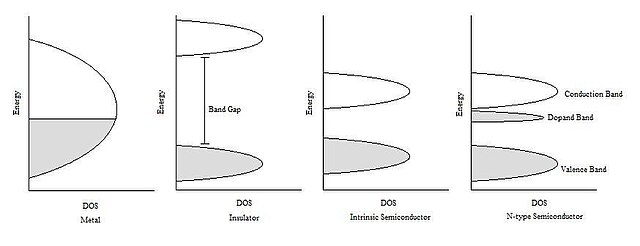
Figure 1: Representative
density of states diagrams of metals, insulators, intrinsic and n-doped semiconductors. Shaded areas represent energy levels filled at absolute zero, below the Fermi energy.
The
Fermi level is the energy below which there is a 50% chance of finding an occupied energy state. The Fermi level can be calculated from the density of states in the conduction and valence bands. The Fermi level may increase, remain the same or decrease with increasing temperature, depending on the number of states in the conduction and valence bands. Where two regions with different Fermi levels are in contact, charge carriers will flow between the two regions until the Fermi level is aligned across the interface.
At
absolute zero temperature the Fermi level can be thought of as the energy up to which available electron states are occupied. At higher temperatures, the Fermi level is the energy at which the probability of a state being occupied has fallen to 0.5.
- atoms – crystal – vacuum
In a single H-atom an electron resides in orbitals labelled s, p, d in order of increasing energy.
-
This can be continued with more atoms. Note: This picture shows a metal, not a semiconductor.
Continuing to add atoms creates a crystal.
For this regular solid the band structure can be calculated or measured.
Integrating over the k axis gives the bands of a semiconductor showing a full valence band and an empty conduction band. Generally stopping at the vacuum level is undesirable, because some people want to calculate:
photoemission,
inverse photoemission
[edit]Holes: electron absence as a charge carrier
The concept of
holes can also be applied to
metals, where the
Fermi level lies
within the conduction band. With most metals the
Hall effect indicates electrons are the charge carriers. However, some metals have a mostly filled conduction band. In these, the
Hall effect reveals positive charge carriers, which are not the ion-cores, but holes. In the case of a metal, only a small amount of energy is needed for the electrons to find other unoccupied states to move into, and hence for current to flow. Sometimes even in this case it may be said that a hole was left behind, to explain why the electron does not fall back to lower energies: It cannot find a hole. In the end in both materials electron-
phonon scattering and defects are the dominant causes for
resistance.

Fermi-Dirac distribution. States with energy ε below the Fermi level, here µ, have higher probability
n to be occupied, and those above are less likely to be occupied. Smearing of the distribution increases with temperature.
The energy distribution of the electrons determines which of the states are filled and which are empty. This distribution is described by
Fermi-Dirac statistics. The distribution is characterized by the
temperature of the electrons, and the
Fermi level. The dependence of the electron energy distribution on temperature also explains why the conductivity of a semiconductor has a strong temperature dependency, as a semiconductor operating at lower temperatures will have fewer available free electrons and holes able to do the work.
[edit]Energy–momentum dispersion
In the preceding description an important fact is ignored for the sake of simplicity: the
dispersionof the energy. The reason that the energies of the states are broadened into a band is that the energy depends on the value of the
wave vector, or
k-vector, of the electron. The k-vector, in quantum mechanics, is the representation of the
momentum of a particle.
The dispersion relationship determines the
effective mass,
m*, of electrons or holes in the semiconductor, according to the formula:
![m^{*} = \hbar^2 \cdot \left[ {{d^2 E(k)} \over {d k^2}} \right]^{-1}.](http://upload.wikimedia.org/math/8/5/5/8550b52cf1bd23437fd1e50d1c4f7746.png)
The effective mass is important as it affects many of the electrical properties of the semiconductor, such as the electron or hole
mobility, which in turn influences the
diffusivity of the charge carriers and the
electrical conductivityof the semiconductor.
Typically the effective mass of electrons and holes are different. This affects the relative performance of
p-channeland
n-channel IGFETs.
[7]
The top of the valence band and the bottom of the conduction band might not occur at that same value of
k. Materials with this situation, such as
silicon and
germanium, are known as
indirect bandgap materials. Materials in which the band extrema are aligned in
k, for example
gallium arsenide, are called
direct bandgap semiconductors. Direct gap semiconductors are particularly important in
optoelectronics because they are much more efficient as light emitters than indirect gap materials; an electron moving between two bands need not exchange momentum with
phonons in the crystal lattice.
[edit]Carrier generation and recombination
When
ionizing radiation strikes a semiconductor, it may excite an electron out of its energy level and consequently leave a hole. This process is known as
electron–hole pair generation. Electron-hole pairs are constantly generated from
thermal energy as well, in the absence of any external energy source.
Electron-hole pairs are also apt to recombine.
Conservation of energy demands that these recombination events, in which an electron loses an amount of
energy larger than the
band gap, be accompanied by the emission of thermal energy (in the form of
phonons) or radiation (in the form of
photons).
As the probability that electrons and holes meet together is proportional to the product of their amounts, the product is in steady state nearly constant at a given temperature, providing that there is no significant electric field (which might "flush" carriers of both types, or move them from neighbour regions containing more of them to meet together) or externally driven pair generation. The product is a function of the temperature, as the probability of getting enough thermal energy to produce a pair increases with temperature, being approximately exp(−
EG/
kT), where
k is
Boltzmann's constant,
T is absolute temperature and
EG is band gap.
The probability of meeting is increased by carrier traps—impurities or dislocations which can trap an electron or hole and hold it until a pair is completed. Such carrier traps are sometimes purposely added to reduce the time needed to reach the steady state.
The conductivity of semiconductors may easily be modified by introducing impurities into their
crystal lattice. The process of adding controlled impurities to a semiconductor is known as
doping. The amount of impurity, or dopant, added to an
intrinsic (pure) semiconductor varies its level of conductivity. Doped semiconductors are referred to as
extrinsic. By adding impurity to pure semiconductors, the electrical conductivity may be varied by factors of thousands or millions.
A 1 cm3 specimen of a metal or semiconductor has of the order of 1022 atoms. In a metal, every atom donates at least one free electron for conduction, thus 1 cm3 of metal contains on the order of 1022 free electrons. Whereas a 1 cm3 of sample pure germanium at 20 °C, contains about 4.2×1022 atoms but only 2.5×1013 free electrons and 2.5×1013 holes. The addition of 0.001% of arsenic (an impurity) donates an extra 1017 free electrons in the same volume and the electrical conductivity is increased by a factor of 10,000.
The materials chosen as suitable dopants depend on the atomic properties of both the dopant and the material to be doped. In general, dopants that produce the desired controlled changes are classified as either electron
acceptors or
donors. Semiconductors doped with
donor impurities are called
n-type, while those doped with
acceptor impurities are known as
p-type. The n and p type designations indicate which charge carrier acts as the material's
majority carrier. The opposite carrier is called the
minority carrier, which exists due to thermal excitation at a much lower concentration compared to the majority carrier.
For example, the pure semiconductor
silicon has four valence electrons which bond each silicon atom to its neighbors. In silicon, the most common dopants are
group III and
group V elements. Group III elements all contain three valence electrons, causing them to function as acceptors when used to dope silicon. When an acceptor atom replaces a silicon atom in the crystal, a vacant state ( an electron "hole") is created, which can move around the lattice and functions as a charge carrier. Group V elements have five valence electrons, which allows them to act as a donor; substitution of these atoms for silicon creates an extra free electron. Therefore, a silicon crystal doped with
boron creates a p-type semiconductor whereas one doped with
phosphorus results in an n-type material.
During
manufacture, dopants can be diffused into the semiconductor body by contact with gaseous compounds of the desired element, or
ion implantation can be used to accurately position the doped regions.
[edit]Preparation of semiconductor materials
Semiconductors with predictable, reliable electronic properties are necessary for
mass production. The level of chemical purity needed is extremely high because the presence of impurities even in very small proportions can have large effects on the properties of the material. A high degree of crystalline perfection is also required, since faults in crystal structure (such as
dislocations,
twins, and
stacking faults) interfere with the semiconducting properties of the material. Crystalline faults are a major cause of defective semiconductor devices. The larger the crystal, the more difficult it is to achieve the necessary perfection. Current mass production processes use crystal
ingots between 100 mm and 300 mm (4–12 inches) in diameter which are grown as cylinders and sliced into
wafers.
Because of the required level of chemical purity and the perfection of the crystal structure which are needed to make semiconductor devices, special methods have been developed to produce the initial semiconductor material. A technique for achieving high purity includes growing the crystal using the
Czochralski process. An additional step that can be used to further increase purity is known as
zone refining. In zone refining, part of a solid crystal is melted. The impurities tend to concentrate in the melted region, while the desired material recrystalizes leaving the solid material more pure and with fewer crystalline faults.
In manufacturing semiconductor devices involving
heterojunctions between different semiconductor materials, the
lattice constant, which is the length of the repeating element of the crystal structure, is important for determining the compatibility of materials.
[edit]Organic materials
Organic semiconductors have been of great research interest for use in low cost, ultra thin, and flexible products such as displays and
solar cells. While many p-type organic semiconductors have been thoroughly characterized, n-type organic semiconductors have proven hard to obtain. Both types are needed for the diodes and transistors that make desirable devices possible. N-type organic semiconductors were produced of the arylene diimide family that are resistant to thermal and environmental stresses, which is one of the largest challenges in the field.
[8]Several other compounds are being explored for n-type organic semiconductors for use in
organic field-effect transistors (OFET), such as
fullerene (C
60) and chemically modified oligothiophenes. Semiconductors are made from these compounds by reduction with electron withdrawing groups or, alternatively, by modifying the surface properties to control electron trapping.
[9] Organic
thin film transistors (OTFTs) are being explored because their low synthesis temperatures allow them to be deposited on thin plastic substrates without damage, resulting in thin and flexible devices. Same compounds are often considered for use in OFETs and OTFTs.
[10]
[edit]Semi-insulators
Some materials are classified as
semi-insulators. These have electrical conductivity nearer to that of electrical insulators. Semi-insulators find niche applications in micro-electronics, such as substrates for
HEMT. An example of a common semi-insulator is
gallium arsenide.
[11]
Semiconductors have had a monumental impact on our society. You find semiconductors at the heart of
microprocessor chips as well as transistors. Anything that's computerized or uses
radio waves depends on semiconductors.
Today, most semiconductor chips and transistors are created withsilicon. You may have heard expressions like "Silicon Valley" and the "silicon economy," and that's why -- silicon is the heart of any electronic device.
A diode is the simplest possible semiconductor device, and is therefore an excellent beginning point if you want to understand how semiconductors work. In this article, you'll learn what a semiconductor is, how doping works and how a diode can be created using semiconductors. But first, let's take a close look at silicon.
Silicon is a very common element -- for example, it is the main element in sand and quartz. If you look "silicon" up in the
periodic table, you will find that it sits next to aluminum, below carbon and above germanium.
Carbon, silicon and germanium (germanium, like silicon, is also a semiconductor) have a unique property in their electron structure -- each has
four electrons in its outer orbital. This allows them to form nice crystals. The four electrons form perfect covalent bonds with four neighboring
atoms, creating a
lattice. In carbon, we know the crystalline form as
diamond. In silicon, the crystalline form is a silvery, metallic-looking substance.
Metals tend to be good conductors of electricity because they usually have "free electrons" that can move easily between atoms, and electricity involves the flow of electrons. While silicon crystals look metallic, they are not, in fact, metals. All of the outer electrons in a silicon crystal are involved inperfect covalent bonds, so they can't move around. A pure silicon crystal is nearly an insulator -- very little electricity will

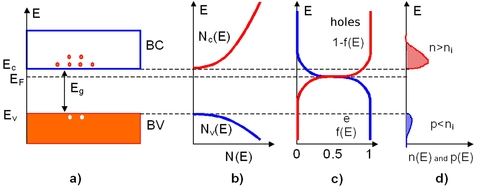
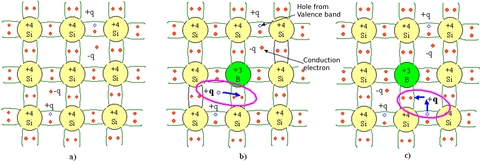
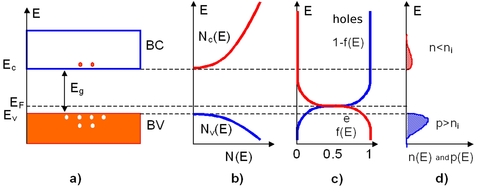
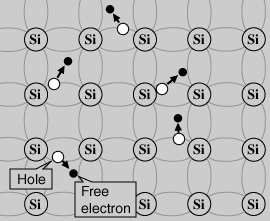
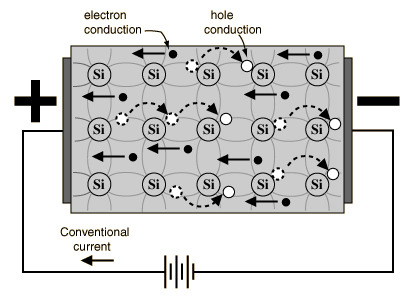
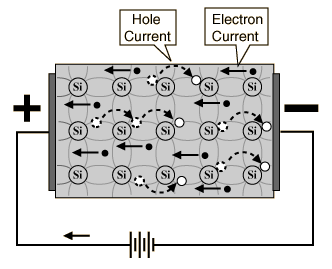


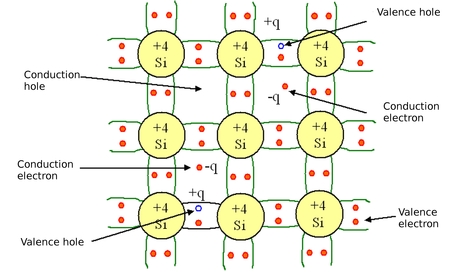
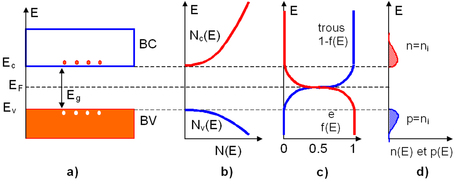


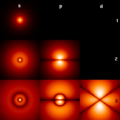






![m^{*} = \hbar^2 \cdot \left[ {{d^2 E(k)} \over {d k^2}} \right]^{-1}.](http://upload.wikimedia.org/math/8/5/5/8550b52cf1bd23437fd1e50d1c4f7746.png)




